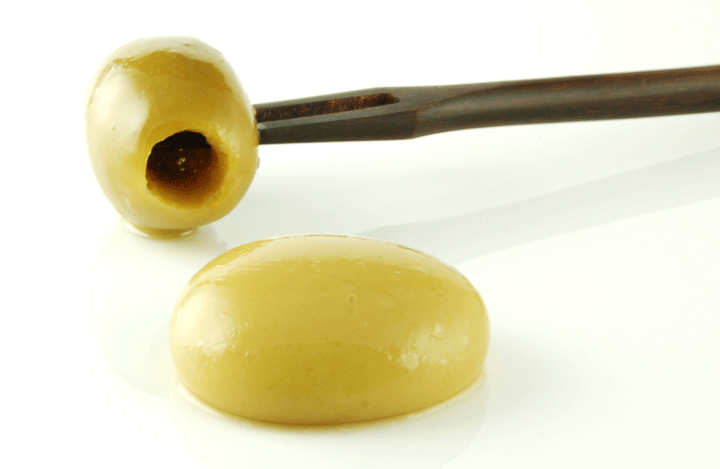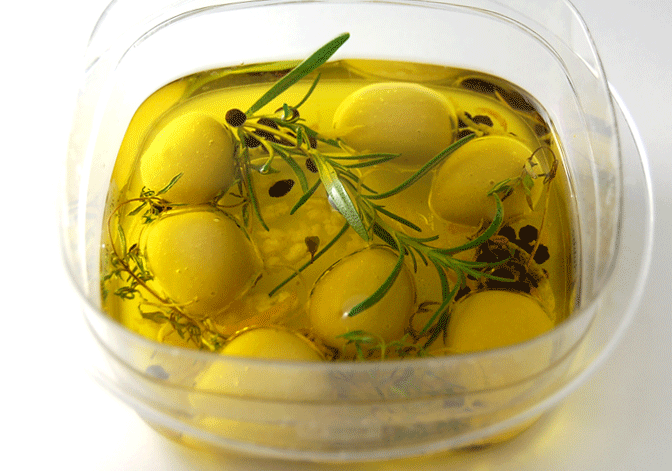Liquid Olives Recipe
This molecular gastronomy recipe is another creation of Ferran Adria and el Bulli team. This is one of the first reverse spherification dishes that was introduced at el Bulli in 2005. The spherical olives are based on green olive juice.
The key of this recipe is to find olives that have a great quality juice that tastes great. These olives are not necessary the best olives for eating so try a few varieties until you find the one you like the most. The first time I made this recipe I made the mistake of using average quality olives and the taste was pretty bad. El Bulli recommends Verdial olives, which are thick-skinned, medium to large-sized olives grown for their oil.

I used Greek Mt. Athos olives with garlic and herbs and the taste was delicious. Just keep in mind that the spherification process is not going to make the juice taste better so try it before you start with the process.
Spherical Olive Ingredients
- 200 g (7 oz) of olive juice (about 500 g of depitted green olives)
- 0.75 g xanthan
- 2 g (1%) calcium lactate gluconate (this is not required in the original recipe from el Bulli but I had to add it to make the spherification process work)
Alginate Bath
- 1500 g (35 oz) of water
- 7.5 g sodium alginate
Aromatized Virgin Olive Oil
- Extra virgin olive oil
- Lemon peel
- Fresh thyme sprigs
- Fresh rosemary sprigs
- Garlic cloves
- Black peppercorns

Preparation
Start by preparing the alginate bath. Mix the sodium alginate in the water using an immersion blender until the sodium alginate is completely dissolved. If this is your first time doing this, be aware that this may take longer than expected. Let it rest for 24 hours in the fridge so that the air that has entered the mixture disappears and the sodium alginate is completely rehydrated.
To prepare the olive juice, puree the depitted olives with a hand mixer and strain the puree through a superbag pressing with the hands. You can try using a blender but because there is no liquid, I couldn't make it work using my Cuisinart blender. If you don’t have a superbag, you can use a chinois / strainer lined with cheese cloth. In this case you'll have to press the olive puree with a spatula to get all the juice out. I found it easier to go through the pressing process in small batches but this would depend on the size of your strainer.
Mix the calcium lactate gluconate with the olive juice and then add the xanthan and leave to hydrate for 1 minute. Mix with a blender at medium speed and let it stand in the fridge for 10 minutes. Check the density of the olive juice. It should be dense like a thick sauce. If you scoop up some olive juice and pour it on the surface of the olive juice in the container, it shouldn't flatten completely right away. If it is too liquid, add some Xanthan in small increments of 0.2 g and repeat the process. Keep in the fridge for 24 hours.
For the aromatized olive oil, crush the garlic lightly and fry it in 20% of the oil you are planning to use to marinate the olives without letting the garlic color. Add the rest of the oil and once it is warm, add the rest of the ingredients. Keep in a sealed container in a cool dry place.
You are now ready to start creating the spheres! Remove the alginate bath from the fridge. Scoop the olive mixture with a half sphere 5ml measure spoon and carefully pour it into the alginate bath. It is important that the spherical olives don’t touch since they would stick together. Leave the spherical olives "cooking" for about 2½ minutes in the alginate bath and then carefully remove it using a slotted spoon. Then rinse them very gently with water, strain them carefully and place them, not touching each other, in the aromatized oil. Keep in the fridge for 12 hours. To improve the technique read 10 Tips to Create a Perfect Sphere.
Serving suggestions
- Serve on appetizer spoons or Chinese soup spoons
- Serve next to traditional olives. It is fun to compare the flavors.





 (10 votes, average: 3.60)
(10 votes, average: 3.60)
